________________
830
. GĪTĀ-RAHASYA OR KARMA-YOGA
that He could not have come into contact, directly or indirectly. with Buddhist monks during this period of His life; because, the activities of Buddhist monks had at that date gone as far as Greece. There is a clear statement in a book to be found in a Buddhist monastary in Nepal that Jesus Christ had at that time come to India, and that He there acquired the knowledge of Buddhism. This book was found by a Russian named Nicholas Notovisch, and he published a translation of it into the French language in 1894. Many Christian scholars say, that though the translation of Notovisch may be correct, the original book itself is a fraud written by some one; and I too am not very emphatic on the position that these scholars should accept that book as authentic. Whether the book found by Notovisch was reliable or not, it will be quite clear from the dissertation made by me above that, from the purely historical point of view, it was not impossible, at least for the disciples of Christ who wrote His life in the New Testament, if not for Christ Himself, to have become acquainted with Buddhism; and if this position is not improbable, it does not appear logical to say that the strange similarity to be found between the lives or the preachings of Christ and Buddha, was something which came into existence independently. In short. the purely ritualistic path of the Mīmāmsakas, the KnowledgeAction (naişkarmya ) path of Janaka and others, the Path of - Knowledge and Renunciation of the writers of the Upanisads and the Sārkhya philosophers, the Pātañjala Yoga in the shape of 'Concentration of the Mind', and the Pāñcarātra or the Bhagavata religion, that is, the Philosophy of Devotion, are all religious paths which grew originally from the ancient Vedic religion. Leaving aside, out of these, the Path of the Knowledge of the Brahman, the Path of Energism, and the Path of Devotion, Buddha has preached his renunciatory religion to the four castes on the basis of the philosophy of (i) Yoga in the form of Concentration of the Mind', and (ii) Karma-Sämnyāga
*
m
.
* The same is the opinion of Mr. Rameshchandra Dutt, and he has expressed it in detail in his book. See Rameshchandra Datt's History of Civilisation in Ancient India Vol. II, Chapter XX PP. 328–340.




